American Native genus/species for bonsai
+10
peewee1974
Mitch - Cedarbog
RKatzin
GeneMartin
Russell Coker
Rob Kempinski
coh
JimLewis
drgonzo
Randy_Davis
14 posters
Page 1 of 2
Page 1 of 2 • 1, 2 
 American Native genus/species for bonsai
American Native genus/species for bonsai
All,
I would like to know if anyone here has some experience collecting American persimmon (D. virginiana) and Sassafras (S. albidum). I have some on my property that I cut down a few years ago during an Ice storm that have regrown and would make nice larger trunked specimens but I don't have any experience on how easy or difficult they are to pull out and get to survive. At the moment I have eyed a few to try and pull in February. I do think that an American persimmion bonsai would be awesome.
I would like to know if anyone here has some experience collecting American persimmon (D. virginiana) and Sassafras (S. albidum). I have some on my property that I cut down a few years ago during an Ice storm that have regrown and would make nice larger trunked specimens but I don't have any experience on how easy or difficult they are to pull out and get to survive. At the moment I have eyed a few to try and pull in February. I do think that an American persimmion bonsai would be awesome.
Last edited by Randy_Davis on Fri Dec 23, 2011 7:07 pm; edited 1 time in total

Randy_Davis- Member
 Re: American Native genus/species for bonsai
Re: American Native genus/species for bonsai
I know that sassafras grows a mighty taproot, and that it will grow straight down for a bit, then hook a left, or right, and continue horizontally....
and that my wife uses the leaves in cooking..She's a 'Nawlin's native.
-Jay
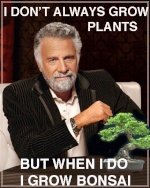
drgonzo- Member
 Re: American Native genus/species for bonsai
Re: American Native genus/species for bonsai
I've never dug persimmon, though we have lots of them around us, puckery fruit and all. The leaves are 1) too large, and 2) much too susceptible to all kinds of rusts, spots, and other ailments and spend most of the year being downright ugly because of it.
I have dug a few sassafras. They do have a deep root, but don't seem to mind it being cut, so long as there are ample side roots. Again, leaves are a bit on the large size and I never saw any reduction, but then as most know, I don't grow many large trees. Their leaves are among the most gorgeous in the fall, however.
I have dug a few sassafras. They do have a deep root, but don't seem to mind it being cut, so long as there are ample side roots. Again, leaves are a bit on the large size and I never saw any reduction, but then as most know, I don't grow many large trees. Their leaves are among the most gorgeous in the fall, however.

JimLewis- Member
 Re: American Native genus/species for bonsai
Re: American Native genus/species for bonsai
JimLewis wrote:I've never dug persimmon, though we have lots of them around us, puckery fruit and all. The leaves are 1) too large, and 2) much too susceptible to all kinds of rusts, spots, and other ailments and spend most of the year being downright ugly because of it.
I have dug a few sassafras. They do have a deep root, but don't seem to mind it being cut, so long as there are ample side roots. Again, leaves are a bit on the large size and I never saw any reduction, but then as most know, I don't grow many large trees. Their leaves are among the most gorgeous in the fall, however.
Thanks Jay and Jim,
I agree that the persimmion gets all kinds of leaf rusts but my plan would be to display this tree in the fall when it is bare of leaves and displaying the ripening fruit, just the same as the Japanese use their native trees for bonsai. The main difference is that the American Persimmon fruit is much smaller and would be more in scale.
I know that the sassafras has a spreading root system and often sprouts new trees from the root system. I'm hoping that the trees that I've selected are root system sprouts rather than seedlings which should make them easier to pull out of the ground. These too would be used for Fall display of the color but more importantly to me, displaying the awesome naural branch structure during the winter. I'm hoping to make a multi-tree grouping which they often do in their natural envionment.

Randy_Davis- Member
 Re: American Native genus/species for bonsai
Re: American Native genus/species for bonsai
I've always thought an American persimmon would be an interesting bonsai subject, but I don't know if they grow this far north (I've never seen any, at least). We do have some sassafras around the property, fall colors are spectacular but I've never contemplated digging any because of the negative things I've read. Please let us know if you attempt to collect these!
Chris
Chris

coh- Member
 Re: American Native genus/species for bonsai
Re: American Native genus/species for bonsai
coh wrote: We do have some sassafras around the property, fall colors are spectacular but I've never contemplated digging any because of the negative things I've read. Please let us know if you attempt to collect these!
Chris
Chris,
As the old saying goes, "nothing ventured, nothing ganed". That is particularly true with native American trees that are not in the mainstream of the bonsai community. On the persimmon, I will be testing out seedlings, some small trees that I've cut back a couple of times, and then a larger one, just to see how it goes. They are thick in this part of Kentucky and come up everywhere. The sassafras just happened to come out of hiding in the weeds when I was looking around the property on my daily walk, so I'll give it a try too!

Randy_Davis- Member
 Re: American Native genus/species for bonsai
Re: American Native genus/species for bonsai
Our club had an opportunity to collect Common Persimmon, (Diospyro virginia) the Florida variety, about 10 years ago. Several of us dug about 10 or 12 and not a one survived beyond a year. Seemed like the native ones have very sparse roots growing in a mucky area. Leaves were big too.

Rob Kempinski- Member
 Re: American Native genus/species for bonsai
Re: American Native genus/species for bonsai
Rob Kempinski wrote:Our club had an opportunity to collect Common Persimmon, (Diospyro virginia) the Florida variety, about 10 years ago. Several of us dug about 10 or 12 and not a one survived beyond a year. Seemed like the native ones have very sparse roots growing in a mucky area. Leaves were big too.
Same experience here, Rob. Years ago (at least 25) our club went digging on the Eglin Reservation, mostly for Pensacola hawthorns. I dug a spectacular natural bunjin persimmon, I still remember it clearly. I wouldn't worry about what the foliage looks like, that's not when they're displayed. Take ume for instance... Who gives a crap about their foliage, that's not why they're grown for bonsai. Same for persimmon.
Can't help with sasafrass, but what about those cool Texas persimmons with the small black fruit?

Russell Coker- Member
 Re: American Native genus/species for bonsai
Re: American Native genus/species for bonsai
Russell Coker wrote:Can't help with sasafrass, but what about those cool Texas persimmons with the small black fruit?
Oh man!, those Texas persimmons are just lovely! I've seen one or two on the net from some folks down in Texas that are just a knock out!!!! They definately should be grown more.
As far as the American Persimmon I'm going to give it the old college try anyway. That's why I'm trying all sizes of trees. I'm quite sure the seedlings will work but I'm sure I won't be alive to see them fruit but what the heck! I enjoy the natural branch structure of mature persimmons and if I can replicate that in a few years I'll be tickled pink.

Randy_Davis- Member
 Re: American Native genus/species for bonsai
Re: American Native genus/species for bonsai
Randy_Davis wrote:Chris,
As the old saying goes, "nothing ventured, nothing ganed". That is particularly true with native American trees that are not in the mainstream of the bonsai community. On the persimmon, I will be testing out seedlings, some small trees that I've cut back a couple of times, and then a larger one, just to see how it goes. They are thick in this part of Kentucky and come up everywhere. The sassafras just happened to come out of hiding in the weeds when I was looking around the property on my daily walk, so I'll give it a try too!
Certainly true! And I do have a few native species that I'm experimenting with that aren't considered "typical" subjects...eastern redbud (cercis canadensis), black locust (robinia pseudoacacia) and tulip poplar (liriodendron) in particular. So why not sassafras? Hmmm...I know where one is located! (upright orange/red tree on right side of photo).
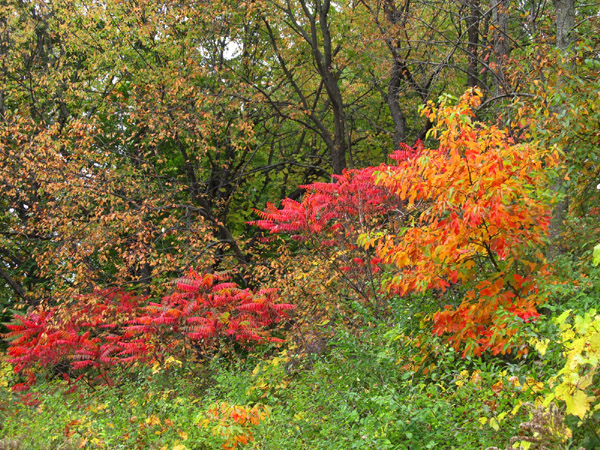
Chris

coh- Member
 America Persimmon fruit
America Persimmon fruit
How old does American Persimmon (Diospyros virginiana) have to be before producing fruit? Thanks.
--Gene
--Gene
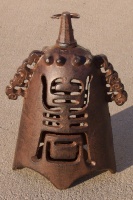
GeneMartin- Member
 Re: American Native genus/species for bonsai
Re: American Native genus/species for bonsai
GeneMartin wrote:How old does American Persimmon (Diospyros virginiana) have to be before producing fruit? Thanks.
--Gene
I've never counted the years, but seedlings near my larger, fruit-bearing, trees in the yard are about 8 feet tall now and have never fruited.

JimLewis- Member
 Re: American Native genus/species for bonsai
Re: American Native genus/species for bonsai
JimLewis wrote:GeneMartin wrote:How old does American Persimmon (Diospyros virginiana) have to be before producing fruit? Thanks.
--Gene
I've never counted the years, but seedlings near my larger, fruit-bearing, trees in the yard are about 8 feet tall now and have never fruited.
Gene and Jim,
In my experience they fruit in about 10-15 years on average from seed very much like pecan trees. If you grow them in containers continually from seed you can just about double that time to fruiting. They are not a tree for those that want instant results and if Russell and Rob are correct about collecting larger trunked specimens and Jim is right about foliage diseases, you can see why they have been neglected. I on the other hand, see the potential so I'm willing to experiment with seed and pass them on to a young bonsai adict intrested in American Natives so they might be lucky enough to enjoy the fruits of another generations labor.

Randy_Davis- Member
 Re: American Native genus/species for bonsai
Re: American Native genus/species for bonsai
coh wrote:Certainly true! And I do have a few native species that I'm experimenting with that aren't considered "typical" subjects...eastern redbud (cercis canadensis), black locust (robinia pseudoacacia) and tulip poplar (liriodendron) in particular. So why not sassafras? Hmmm...I know where one is located!
Chris
Chris,
That's a good list to start with! I've tried Eastern redbud from seed and while it took a while it did perform quite nicely with leaves reducing to about the size of a silver dollar. I was just sick when I lost it due to an illness that kept me on my back for 2 years. I've seen a pic of the European redbud (C. siliquastrum) done as bonsai that was just outstanding by someone in Europe so there is hope for the American form. I'd like to hear about your expeirences with Black Locust and Tulip Poplar as I've never considered them. I'll be digging out a number of common trees to give a whirl at this year. Besides Persimmon and Sassafras, I'll be digging Black Cherry (Prunus serotina), Possum-haw female (Ilex decidua) and Honey Locust (Gleditsia triacanthos) a very small bipinnately leaved tree with thorns that I'm going to try in the African Flat-top style.
Last edited by Randy_Davis on Tue Dec 20, 2011 3:04 pm; edited 1 time in total

Randy_Davis- Member
 Re: American Native genus/species for bonsai
Re: American Native genus/species for bonsai
Funny thing is as I'm going through Japanese bonsai magazines I often see them using their persimmons with big leaves and big fruit as bonsai - but they are almost always photographed in winter. They always look a little like Charlie Brown Christmas trees, but they admire them for what they are. We're the ones that seem to be hung up on foliage that's "too big". Personally, I think they'd go nuts over our native persimmons. Compared with theirs the leaves are smaller, the fruit is a wonderful size, and the twigging is far more attractive. Of course the problem with collecting them or growing from seed is that they're dioecious, so I guess it would be years before you know if it's male or female. Another problem with collecting is making sure it's a stand alone plant. I'll bet that a lot of those "seedling" are actually root suckers.
If I remember correctly from my college Plant Materials classes, the male trees develop a very rough, dark, heavy bark with age while the female trees remain rather smooth. It was an easy way to tell them apart from a distance, and less intrusive than looking between their legs.
If I remember correctly from my college Plant Materials classes, the male trees develop a very rough, dark, heavy bark with age while the female trees remain rather smooth. It was an easy way to tell them apart from a distance, and less intrusive than looking between their legs.

Russell Coker- Member
 Re: American Native genus/species for bonsai
Re: American Native genus/species for bonsai
Russell Coker wrote:Funny thing is as I'm going through Japanese bonsai magazines I often see them using their persimmons with big leaves and big fruit as bonsai - but they are almost always photographed in winter. They always look a little like Charlie Brown Christmas trees, but they admire them for what they are. We're the ones that seem to be hung up on foliage that's "too big". Personally, I think they'd go nuts over our native persimmons. Compared with theirs the leaves are smaller, the fruit is a wonderful size, and the twigging is far more attractive. Of course the problem with collecting them or growing from seed is that they're dioecious, so I guess it would be years before you know if it's male or female. Another problem with collecting is making sure it's a stand alone plant. I'll bet that a lot of those "seedling" are actually root suckers.
If I remember correctly from my college Plant Materials classes, the male trees develop a very rough, dark, heavy bark with age while the female trees remain rather smooth. It was an easy way to tell them apart from a distance, and less intrusive than looking between their legs.
Oh Russell,
I'm always looking at tree crotches! I'm not ashamed to admit it!!!!!!
I have always wondered what the percentage of male to female ratio is on seedlings but I don't think there's any data on that. As a way around that, I'm probably going to take the seedlings when they are ready and make a multi-tree forest out of them. I've also wondered if there is a difference on survival rate based on soil type and depth. I have a piece of land that has some trees on it that has a rather thin layer of clay with gravel underneath and I'm hopeing that combination produces a more fibrous root system that's shallow. That piece of land sure produces stunted slower growth on most of the other trees. I'll have some results by summers end next year that I can report on. I agree with you that they would go wild about the fruit size of our native. I like a fool, was on my way over to my local friends to visit them and ran across an outstand tree just covered in fruit and bare of leaves and neglected to snap a picture of it. It was just an awesome sight and it really has my juices flowing to give persimmon a try.

Randy_Davis- Member
 Re: American Native genus/species for bonsai
Re: American Native genus/species for bonsai
Randy,
I just started with the locust - took an air layer off a small tree in my yard. Hopefully it will survive it's first winter. If not, there's plenty of additional material around (and it rooted very quickly). I don't know how well it will work, but I can imagine it possibly being used like a wisteria - displayed during its short bloom season.
We have hundreds of redbud seedlings courtesy of trees in my neighbors yard. Seems like every seed sprouts! They do seem to develop a strong taproot and I've lost a few that I've tried to transplant. The one I'm working with had the "misfortune" to sprout under a fence, so the lower trunk is strongly bent. It could turn out interesting, but the roots aren't very good. I will probably be experimenting with some of the other volunteers as well.
Tulip poplar...who knows! I've tried layering branches off a yard tree without success, so I'll probably pick up a couple of seedlings in the spring. Don't know how much the leaves might reduce but the leaf shape is so interesting that I think it's worth a try.
Many of my pre-conceived notions about leaf size went out the window when I saw photos of horse-chestnut bonsai (I think Walter has one). Never imagined those would work! But they did, so I figure almost anything is worth a try.
Chris
I just started with the locust - took an air layer off a small tree in my yard. Hopefully it will survive it's first winter. If not, there's plenty of additional material around (and it rooted very quickly). I don't know how well it will work, but I can imagine it possibly being used like a wisteria - displayed during its short bloom season.
We have hundreds of redbud seedlings courtesy of trees in my neighbors yard. Seems like every seed sprouts! They do seem to develop a strong taproot and I've lost a few that I've tried to transplant. The one I'm working with had the "misfortune" to sprout under a fence, so the lower trunk is strongly bent. It could turn out interesting, but the roots aren't very good. I will probably be experimenting with some of the other volunteers as well.
Tulip poplar...who knows! I've tried layering branches off a yard tree without success, so I'll probably pick up a couple of seedlings in the spring. Don't know how much the leaves might reduce but the leaf shape is so interesting that I think it's worth a try.
Many of my pre-conceived notions about leaf size went out the window when I saw photos of horse-chestnut bonsai (I think Walter has one). Never imagined those would work! But they did, so I figure almost anything is worth a try.
Chris

coh- Member
 Re: American Native genus/species for bonsai
Re: American Native genus/species for bonsai
coh wrote:I just started with the locust - took an air layer off a small tree in my yard. Hopefully it will survive it's first winter. If not, there's plenty of additional material around (and it rooted very quickly). I don't know how well it will work, but I can imagine it possibly being used like a wisteria - displayed during its short bloom season.
I have some here on the property too but have always thought they would be difficult to leaf reduce with their bipinnate leaves. However, I might air-layer one and give it a try too. It seems to me that most (not all) Eastern deciduous trees need to be done a bit larger than one normally thinks of as bonsai (say 3 feet or so). At that height this tree may work and it sure would be pretty in flower.
coh wrote:Tulip poplar...who knows! I've tried layering branches off a yard tree without success, so I'll probably pick up a couple of seedlings in the spring. Don't know how much the leaves might reduce but the leaf shape is so interesting that I think it's worth a try.
Now that's a tree that's going to be difficult no matter how hard you try! I don't think they will leaf reduce and to make them look natural it also needs to be a quite larger tree to make it look right. But as you say, no harm in trying.
coh wrote:Many of my pre-conceived notions about leaf size went out the window when I saw photos of horse-chestnut bonsai (I think Walter has one). Never imagined those would work! But they did, so I figure almost anything is worth a try.
I think and in some cases know there are many other tree types not typically used that with the right imagination (larger and natural style in my case) will make quite fine specimens. There is not only European horse chesnut (Aesculus hippocastanum) but a native of california (Aesculus californica) that make lovely bonsai as well. I have always felt that there needs to be an accepted style called the "American Tall Tree" that would be in the 3-4' hight range to accomidate all of those north american trees that are generally over 100 feet in height in their natural habitat. I see attempts to do California redwood in the traditional styles and they just never have the grandure that one experiences when you see them live and close up in the forest setting. As I'm in my twilight years of bonsai now, I'm heading in that new direction and playing with lots of different genus/species and trying new style forms regarless of what the old guard of bonsai say about it! It's fun to feel free enough to explore again! Nothing ventured, nothing gained!

Randy_Davis- Member
 Re: American Native genus/species for bonsai
Re: American Native genus/species for bonsai
A bonsai tulip-poplar covered in flowers would be a sight indeed! The flowers are so spectacular. Unfortunately, they tend to be high up in the trees and almost invisible from the ground.
Chris
Chris

coh- Member
 Re: American Native genus/species for bonsai
Re: American Native genus/species for bonsai
Randy_Davis wrote:I think and in some cases know there are many other tree types not typically used that with the right imagination (larger and natural style in my case) will make quite fine specimens. There is not only European horse chesnut (Aesculus hippocastanum) but a native of california (Aesculus californica) that make lovely bonsai as well. I have always felt that there needs to be an accepted style called the "American Tall Tree" that would be in the 3-4' hight range to accomidate all of those north american trees that are generally over 100 feet in height in their natural habitat. I see attempts to do California redwood in the traditional styles and they just never have the grandure that one experiences when you see them live and close up in the forest setting. As I'm in my twilight years of bonsai now, I'm heading in that new direction and playing with lots of different genus/species and trying new style forms regarless of what the old guard of bonsai say about it! It's fun to feel free enough to explore again! Nothing ventured, nothing gained!
Yes, those California trees...I've spent a fair amount of time amongst the redwoods and sequoias and that left a big impact. Have seen lots of photos of redwood bonsai, some of which look pretty good...but haven't seen any in person. I am working with a coast redwood and am trying to figure out how tall it should be...ultimately a compromise between reproducing some of that grandeur and keeping it manageable with my back problems! I think I'm going to have to leave the 4 footers to someone else.
Chris

coh- Member
 Re: American Native genus/species for bonsai
Re: American Native genus/species for bonsai
Here's a little something I like to gather from the forest, this is a Red Osier Dogwood (Cornus stolonifera) in its glorious fall colors. The naked tree in winter is very attractively clad in cherry red bark. The leaf is somewhat large, but does reduce nicely once you develop twiggyness.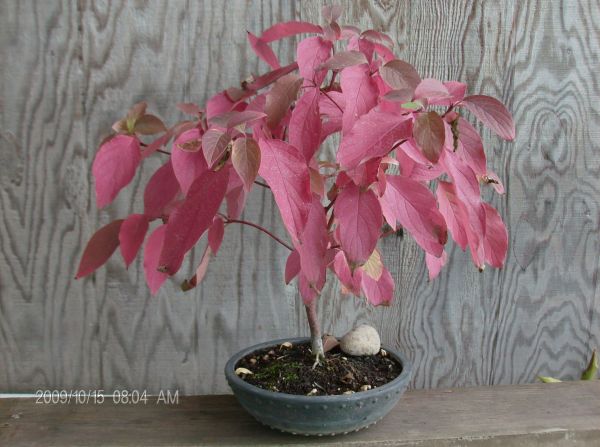 These trees generally grow in the same vacinity as my other favorite wild tree, the Vine Maple (Acer circinatum), a highly overlooked national treasure. These trees are very similar in characteristics to the Mountain Maples of Japan (Acer palmatum)
These trees generally grow in the same vacinity as my other favorite wild tree, the Vine Maple (Acer circinatum), a highly overlooked national treasure. These trees are very similar in characteristics to the Mountain Maples of Japan (Acer palmatum)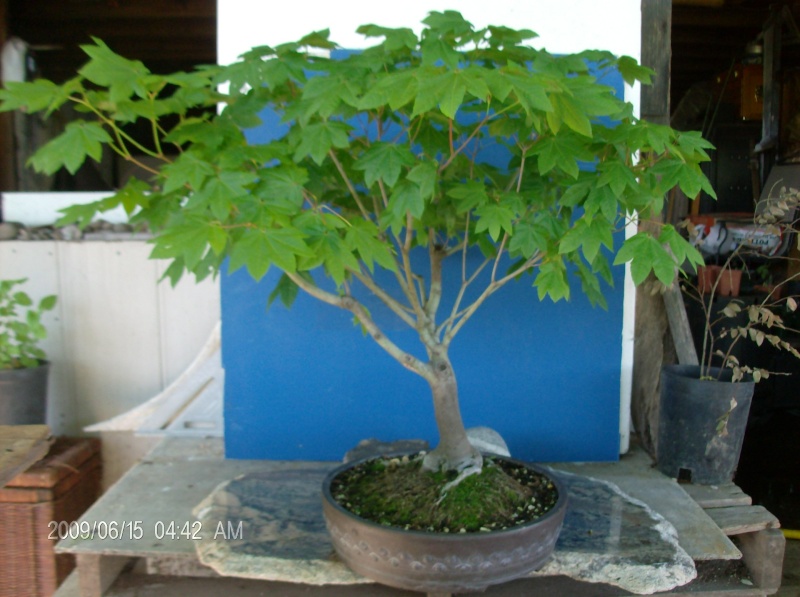 . Both these trees have since been unpotted and planted into the gareden for further growth. I have a few Eastern Redbud growing, but did you know there is a Western Redbud (Cercis occidentalis). It is generally a much smaller tree than its eastern cousin in all aspects. It grows in N. Cal. and SW Or. and is common in the Grand Canyon of Arizona. Sorry I don't seem to have a pic of that one or the other I'd like to mention, which is Oregon Myrtle or California Bay Laurel or Bayberry tree. Naturally a short stout tree not much over thirty feet, but with trunks in the three to four foot range. If anyone remembers the Biscut Fire, it was the biggest in US history in 2001-2002, anyway, it burned over large stands of this tree and, though being burned to a stump, many of them survived and are now grown back into four to five footers with huge trunks. I've got my eye on a couple to dig in late winter. Another native, if you're looking for an apple variety, is the Oregon Crab Apple (Malus fusca) On the Redwoods, just let me first say that I love every Redwood bonsai I've ever seen, yeah but, I've never seen one that looks like a mature specimen. I mean that they look like one hundred year old Redwoods, beautiful in every respect, but if you've seen the three-thousand year old olds, you know what I mean. Thirty feet at the base, one-hundred and fifteen feet up to the first branch, which is twelve feet in diameter and reaches almost one hundred feet from the trunk, which goes up another two hundred feet. There are not many branches on this tree and the top is flat, no pointy tip up here. The most common formation of this tree is not a solitary trunk, but rather a clump or cluster of trunks and my most humble opinion is that this is how they look best as bonsai. I'm just sayin'. They appear from a distance to be individual trunks, but when you walk up on them you see they are mutiple trunks eminating from the same base. Sometimes several trees have grown into one as they got bigger, but these trees also sucker profusely from the base of the trunk and these form a cluster or clump as they grow out. Well, that's some of the natives I'm working with right now, but there's the conifers, spruces, pines, firs, yew, hemlock and others all out my back door. I'll show you one yamadori Ponderosa Pine I have my sites on.
. Both these trees have since been unpotted and planted into the gareden for further growth. I have a few Eastern Redbud growing, but did you know there is a Western Redbud (Cercis occidentalis). It is generally a much smaller tree than its eastern cousin in all aspects. It grows in N. Cal. and SW Or. and is common in the Grand Canyon of Arizona. Sorry I don't seem to have a pic of that one or the other I'd like to mention, which is Oregon Myrtle or California Bay Laurel or Bayberry tree. Naturally a short stout tree not much over thirty feet, but with trunks in the three to four foot range. If anyone remembers the Biscut Fire, it was the biggest in US history in 2001-2002, anyway, it burned over large stands of this tree and, though being burned to a stump, many of them survived and are now grown back into four to five footers with huge trunks. I've got my eye on a couple to dig in late winter. Another native, if you're looking for an apple variety, is the Oregon Crab Apple (Malus fusca) On the Redwoods, just let me first say that I love every Redwood bonsai I've ever seen, yeah but, I've never seen one that looks like a mature specimen. I mean that they look like one hundred year old Redwoods, beautiful in every respect, but if you've seen the three-thousand year old olds, you know what I mean. Thirty feet at the base, one-hundred and fifteen feet up to the first branch, which is twelve feet in diameter and reaches almost one hundred feet from the trunk, which goes up another two hundred feet. There are not many branches on this tree and the top is flat, no pointy tip up here. The most common formation of this tree is not a solitary trunk, but rather a clump or cluster of trunks and my most humble opinion is that this is how they look best as bonsai. I'm just sayin'. They appear from a distance to be individual trunks, but when you walk up on them you see they are mutiple trunks eminating from the same base. Sometimes several trees have grown into one as they got bigger, but these trees also sucker profusely from the base of the trunk and these form a cluster or clump as they grow out. Well, that's some of the natives I'm working with right now, but there's the conifers, spruces, pines, firs, yew, hemlock and others all out my back door. I'll show you one yamadori Ponderosa Pine I have my sites on.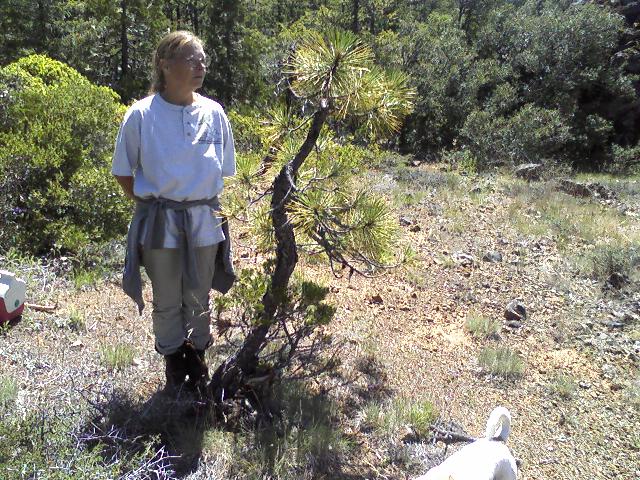 with my lovely 5'2" wife, Shelley. Yep! I'm a big fan of American native trees.
with my lovely 5'2" wife, Shelley. Yep! I'm a big fan of American native trees.
 These trees generally grow in the same vacinity as my other favorite wild tree, the Vine Maple (Acer circinatum), a highly overlooked national treasure. These trees are very similar in characteristics to the Mountain Maples of Japan (Acer palmatum)
These trees generally grow in the same vacinity as my other favorite wild tree, the Vine Maple (Acer circinatum), a highly overlooked national treasure. These trees are very similar in characteristics to the Mountain Maples of Japan (Acer palmatum) . Both these trees have since been unpotted and planted into the gareden for further growth. I have a few Eastern Redbud growing, but did you know there is a Western Redbud (Cercis occidentalis). It is generally a much smaller tree than its eastern cousin in all aspects. It grows in N. Cal. and SW Or. and is common in the Grand Canyon of Arizona. Sorry I don't seem to have a pic of that one or the other I'd like to mention, which is Oregon Myrtle or California Bay Laurel or Bayberry tree. Naturally a short stout tree not much over thirty feet, but with trunks in the three to four foot range. If anyone remembers the Biscut Fire, it was the biggest in US history in 2001-2002, anyway, it burned over large stands of this tree and, though being burned to a stump, many of them survived and are now grown back into four to five footers with huge trunks. I've got my eye on a couple to dig in late winter. Another native, if you're looking for an apple variety, is the Oregon Crab Apple (Malus fusca) On the Redwoods, just let me first say that I love every Redwood bonsai I've ever seen, yeah but, I've never seen one that looks like a mature specimen. I mean that they look like one hundred year old Redwoods, beautiful in every respect, but if you've seen the three-thousand year old olds, you know what I mean. Thirty feet at the base, one-hundred and fifteen feet up to the first branch, which is twelve feet in diameter and reaches almost one hundred feet from the trunk, which goes up another two hundred feet. There are not many branches on this tree and the top is flat, no pointy tip up here. The most common formation of this tree is not a solitary trunk, but rather a clump or cluster of trunks and my most humble opinion is that this is how they look best as bonsai. I'm just sayin'. They appear from a distance to be individual trunks, but when you walk up on them you see they are mutiple trunks eminating from the same base. Sometimes several trees have grown into one as they got bigger, but these trees also sucker profusely from the base of the trunk and these form a cluster or clump as they grow out. Well, that's some of the natives I'm working with right now, but there's the conifers, spruces, pines, firs, yew, hemlock and others all out my back door. I'll show you one yamadori Ponderosa Pine I have my sites on.
. Both these trees have since been unpotted and planted into the gareden for further growth. I have a few Eastern Redbud growing, but did you know there is a Western Redbud (Cercis occidentalis). It is generally a much smaller tree than its eastern cousin in all aspects. It grows in N. Cal. and SW Or. and is common in the Grand Canyon of Arizona. Sorry I don't seem to have a pic of that one or the other I'd like to mention, which is Oregon Myrtle or California Bay Laurel or Bayberry tree. Naturally a short stout tree not much over thirty feet, but with trunks in the three to four foot range. If anyone remembers the Biscut Fire, it was the biggest in US history in 2001-2002, anyway, it burned over large stands of this tree and, though being burned to a stump, many of them survived and are now grown back into four to five footers with huge trunks. I've got my eye on a couple to dig in late winter. Another native, if you're looking for an apple variety, is the Oregon Crab Apple (Malus fusca) On the Redwoods, just let me first say that I love every Redwood bonsai I've ever seen, yeah but, I've never seen one that looks like a mature specimen. I mean that they look like one hundred year old Redwoods, beautiful in every respect, but if you've seen the three-thousand year old olds, you know what I mean. Thirty feet at the base, one-hundred and fifteen feet up to the first branch, which is twelve feet in diameter and reaches almost one hundred feet from the trunk, which goes up another two hundred feet. There are not many branches on this tree and the top is flat, no pointy tip up here. The most common formation of this tree is not a solitary trunk, but rather a clump or cluster of trunks and my most humble opinion is that this is how they look best as bonsai. I'm just sayin'. They appear from a distance to be individual trunks, but when you walk up on them you see they are mutiple trunks eminating from the same base. Sometimes several trees have grown into one as they got bigger, but these trees also sucker profusely from the base of the trunk and these form a cluster or clump as they grow out. Well, that's some of the natives I'm working with right now, but there's the conifers, spruces, pines, firs, yew, hemlock and others all out my back door. I'll show you one yamadori Ponderosa Pine I have my sites on. with my lovely 5'2" wife, Shelley. Yep! I'm a big fan of American native trees.
with my lovely 5'2" wife, Shelley. Yep! I'm a big fan of American native trees.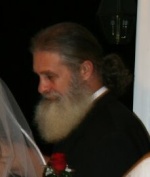
RKatzin- Member
 Re: American Native genus/species for bonsai
Re: American Native genus/species for bonsai
I wonder if ground layering a persimmon would increase the odds of success with collecting a mature tree.
Years ago (maybe 17) I collected a Tulip Popular from a ditch next to a road near my wife's farm in Virgina. Each month the county grass cutting crew would come along and whack it back - they probably did this for 15 years. It had an amazingly contorted trunk - with hollows , twists and deadwood - but alas it didn't survive the Houston heat (I was living in Texas then).
A couple of native trees we should see more of are the southern pines: Pinus virginiana (Scrub Pine or Virginia Pine), Pinus enchinata (Shortleaf pine- I'd really like to see one of these as a bonsai), Pinus taeda (Loblolly Pine), and Pinus elliottii (Slash Pine - I have one of these as a bonsai - amazing bark in a short period of time but quite long needles. Good for larger bonsai in a sort of weeping style.)
Years ago (maybe 17) I collected a Tulip Popular from a ditch next to a road near my wife's farm in Virgina. Each month the county grass cutting crew would come along and whack it back - they probably did this for 15 years. It had an amazingly contorted trunk - with hollows , twists and deadwood - but alas it didn't survive the Houston heat (I was living in Texas then).
A couple of native trees we should see more of are the southern pines: Pinus virginiana (Scrub Pine or Virginia Pine), Pinus enchinata (Shortleaf pine- I'd really like to see one of these as a bonsai), Pinus taeda (Loblolly Pine), and Pinus elliottii (Slash Pine - I have one of these as a bonsai - amazing bark in a short period of time but quite long needles. Good for larger bonsai in a sort of weeping style.)

Rob Kempinski- Member
 Re: American Native genus/species for bonsai
Re: American Native genus/species for bonsai
hey Rob, I have a few virginia pines set for collect when I get back. One is a masterpiece.....in due time.Rob Kempinski wrote:I wonder if ground layering a persimmon would increase the odds of success with collecting a mature tree.
Years ago (maybe 17) I collected a Tulip Popular from a ditch next to a road near my wife's farm in Virgina. Each month the county grass cutting crew would come along and whack it back - they probably did this for 15 years. It had an amazingly contorted trunk - with hollows , twists and deadwood - but alas it didn't survive the Houston heat (I was living in Texas then).
A couple of native trees we should see more of are the southern pines: Pinus virginiana (Scrub Pine or Virginia Pine), Pinus enchinata (Shortleaf pine- I'd really like to see one of these as a bonsai), Pinus taeda (Loblolly Pine), and Pinus elliottii (Slash Pine - I have one of these as a bonsai - amazing bark in a short period of time but quite long needles. Good for larger bonsai in a sort of weeping style.)

Mitch - Cedarbog- Member
 Re: American Native genus/species for bonsai
Re: American Native genus/species for bonsai
Sweetgum (liquidambar styraciflua) is another native that I'm working with...love the fall color.

coh- Member
Page 1 of 2 • 1, 2 
 Similar topics
Similar topics» Utilizing native North American species
» A Quick Book Review : NATIVE NORTH AMERICAN PLANTS FOR BONSAI
» Trying to identifiy Genus and Species for collected Pyracantha
» Native American and ?European? white pines
» question about fruits on my native guava bonsai
» A Quick Book Review : NATIVE NORTH AMERICAN PLANTS FOR BONSAI
» Trying to identifiy Genus and Species for collected Pyracantha
» Native American and ?European? white pines
» question about fruits on my native guava bonsai
Page 1 of 2
Permissions in this forum:
You cannot reply to topics in this forum







